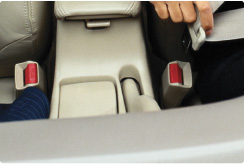
| industry insights | |
| introduction | |
| features | |
| departments/columns | |
| Industry Trends | |
| Perspective | |
| Guest Perspective | |
| Interview | |
| Interview | |
| CCC News Wire | |
| who we are | |
| archives | |
| CCC UpFront home |
| guest perspective |
| Putting Driver Safety into Context |
| Article contributed by Jeffrey Runge, MD |
More than 42,000 people were killed in automobile accidents in 2002. An additional 2.9 million were injured. This cannot just be viewed as a transportation problem. It is a public health problem – one of epidemic proportions. Even more than that, traffic injury is a disease. The good news is that this disease has a cure. A key part of that cure is eliminating key factors that lead up to an accident; most importantly seatbelt use and reducing impaired driving. These two categories account for a full 2/3 of the lives that can be saved. The final 1/3 represents all other factors combined, ranging from eliminating roadway departures to improving truck safety.
Wearing seatbelts is the number one offensive and defensive step all individuals can take to save their lives. Seatbelt use cuts the risk of death in a severe crash by 50 percent. Buckling belts is not a complex vaccine, doesn’t have unwanted side effects and doesn’t cost any money. It is simple, it works and it’s lifesaving. Current NHTSA statistics put seatbelt use at 75 percent. If that number increased to 95 percent, an estimated 4,000 more lives would be saved each year. IMPAIRED DRIVING Since that time, however, progress has stalled. The number of people killed in alcohol-related crashes after 1994 has remained level or even shown a slight increase. There were more than 1.5 million driving while intoxicated (DWI) arrests and 17,400 alcohol-related traffic deaths in 2002. So what can be done? Alcohol impairment is a complex social problem with a range of potential countermeasures. To make real progress, we should focus on three critical areas. 1. The public must perceive that if you are to drink and drive, you will be caught. No exceptions or excuses. 2. DWI needs to be seen as a violent crime. Many of the prosecutors “cut their teeth” on DWI cases until they move on to “more serious” crimes. These cases are complicated and need experienced prosecutors. Specialized DWI courts are effective in improving case management as well as reducing rates of recidivism. This format seems to work well. 3. Compelling scientific and medical evidence shows screening and intervention is effective in decreasing alcohol consumption among problem drinkers. Increasing roadway safety is only achievable with a commitment from everyone, whether it’s actively promoting seatbelt use or engaging yourself in efforts to reduce impaired driving. Start with yourself and your loved ones. Buckle up, regardless of how quick the trip may be. Get the keys from a friend who’s been drinking. Not only will you make the roads safer for them, you’ll make it safer for all of us. The National Highway Traffic Safety Administration (NHTSA), under the U.S. Dept. of Transportation, is responsible for reducing deaths, injuries and economic losses resulting from motor vehicle crashes. *Note: This article was developed with excerpts of speeches given by Dr. Runge. |
 SEATBELT USE
SEATBELT USE